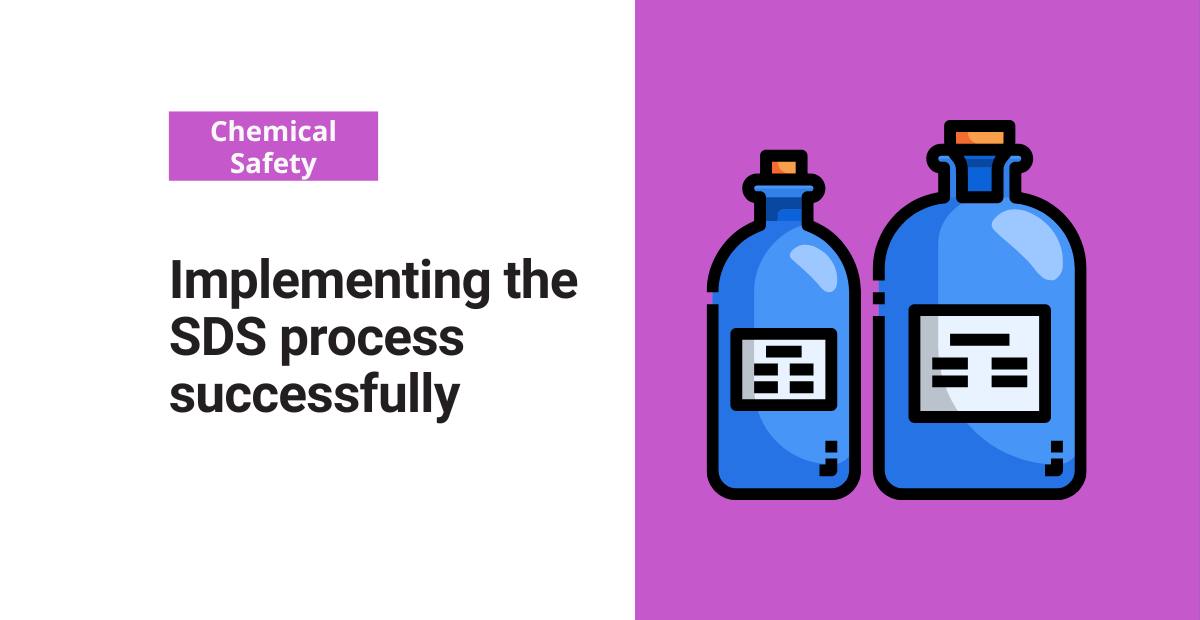The SDS process is a dreaded topic amongst many safety professionals.
How does it work? What do we do with all the SDS’s that come in? How do we track them? Who approves them? Wait, is there an approval process? How do we set it up here?
All of these are good questions, and they represent exactly why many companies are simply not compliant. I have some great tips that you can use to build your SDS process from the ground up and to remain compliant moving forward.
This can be a lot of information, and there are a lot of rabbit holes you can go down regarding this topic. I could try to tackle the entire Hazard Communication standard in one post, but for now, I’ll simply focus on the safety data sheet requirement.
Creating a baseline
The first step in compliance is having a list of all the currently known hazardous chemicals onsite. More than that, I’d recommend that this list be the baseline for your project.
Hopefully, someone within your organization has been keeping track of the hazardous materials. If not, it’s often best to simply build a new list from scratch (this is very common).
Whether you start from scratch or not, get to know the chemicals you have and make sure the SDS for each of them is current. Most countries have a five-year revision requirement, so ensure that your SDS’s are within this timeframe.
Generating a master list
If there are hazardous chemicals onsite with a missing or outdated MSDS (material safety data sheet), you can move to the second step of the SDS implementation process.
The second step is to take a full inventory of all the hazardous chemicals onsite, not just the ones within your baseline list. Depending on the state of your purchasing records and whether anyone has brought new chemicals to the facility without declaring them, you could pull records to get your inventory.
However, in my experience, there are almost always instances where someone has brought a “trial” product or other chemical onsite without going through purchasing. This is where you must physically audit the entire site yourself, putting eyes on every chemical and adding them to your inventory.
After you get your physical inventory, you need to look up the SDS or contact the manufacturer to get one. Some companies use a third-party company to maintain a comprehensive database of safety data sheets.
This is nice to have, but how do you do it without this luxury?
I would recommend using a compliance calendar within your EHS software system. If you’re still using archaic systems like Excel and Outlook Calendar, give yourself those reminders periodically. I would suggest auditing your SDS’s at least once per year.
Maintaining your master inventory
HazCom compliance will be impossible if you don’t have a comprehensive view of all the chemicals within your facility. But within the chaos of the operation, many of us struggle to stay on top of our inventory.
So, you might be wondering: “how exactly do you maintain a master list?”
Here’s the ideal system that would allow you to maintain a master list with relatively few headaches:
Develop an established approval system for bringing hazardous materials in and out of the facility/worksite. Any time a product is ordered, the request goes into the system, and you must approve it prior to the chemical coming onsite.
You can establish this system through your EHS software provider, purchasing, or management team. However you do it, this approval system is the easiest way to keep track of what’s onsite and to ensure you have an SDS for it.
Another way to maintain your master inventory is to set up a reporting process through your receiving department. This is almost like collecting lagging indicator data though, and it doesn’t prevent chemicals from coming into the worksite.
If you decide this is the only route you can take to collect and maintain your master list, make sure you do it correctly. Get with your receiving department and set up a weekly receiving report. Most of the receiving software, even the archaic ones, will allow you to export these reports to Excel.
I highly encourage you to follow the approval process if you want to decrease your risk of allowing unidentified materials onsite.
Access and distribution
Once you’re successfully maintaining your SDS’s, you need to give your employees access to them. How do you do that? Let’s review two different options.
The best way to make SDS’s accessible at all times is to make them available online. You can do this through many channels, including:
- EHS software platform
- SharePoint
- Google Drive
If you do this, I suggest creating a QR code that you can post around your facility so workers can easily find and review the SDS they need.
The second option for SDS distribution is to keep hard copies of all your SDS’s in a well-labeled, central storage location onsite. This option requires much more oversight and clerical work, but sometimes you may not have the budget for a digital solution.
I’d like to point out that the best option is to have the digital storage system and a backup of hard copies just in case.
SDS process training
I can’t leave this subject without mentioning how essential it is to train your employees to follow the SDS process. OSHA requires you train your employees on the hazardous chemicals in their work area both prior to assignment and any time new hazards are introduced.
Train employees in the language they understand and make sure to teach them:
- Where the hazardous chemicals are located
- How to read an SDS
- How to protect themselves against exposure hazards
- Who to contact in case of emergency
For more details on the Hazardous Communication Standard, I recommend you visit OSHA’s site here. Implementing the SDS process successfully requires you to fully understand which areas of your operation fall under this standard and to ensure that employees know exactly what the process is and how to follow it.

Jason Hathcoat
Jason is a seasoned EHS professional with more than 17 years of experience working in health and safety. He currently works as an EHS manager for a large global HVAC company.




